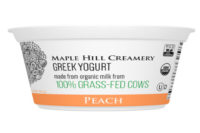What kind of milk is best for the body and the planet is a topic of much debate. Organic dairy products provide higher levels of certain fatty acids, and the organic label ensures freedom from synthetic fertilizers, pesticides and GMOs in the feedstuffs. However, dairy products made from milk produced by grass-fed cows offer even higher levels of beneficial fatty acids and, some say, a more natural and environmentally sound dairy farming experience.
As outlined in the June issue of Dairy Foods, Organic dairy matures, finds new areas for growth, growth in organic dairy has leveled off. In 2018, sales of organic cow’s milk in the United States were $1.36 billion, roughly 5.5% of all fluid milk product sales, but growth had slowed to less than 1%.
In contrast, sales of grass-fed organic dairy products were about $100 million and grew by 56% in 2018. Producing milk from strictly grass-fed cows provides an opportunity for small farms to distinguish themselves and command a higher milk price.
“We are 100% grass fed because of the health benefits of the milk,” said Ron Holter, an Organic Valley dairy farmer in Maryland. “Our passion and commitment, to ourselves and our customers, is to produce the best possible product.”
Symbols and standards
The USDA’s National Organic Program has strict standards for environmental sustainability, and cows must have access to certified organic pasture for the entire grazing season. The season can vary by geographic climate, but must be at least 120 days.
Pasture-raised cows graze certified organic pasture whenever weather permits and receive supplemental grain rations. One-hundred-percent grass-fed cows receive only fresh pasture and dried forages such as hay, as well as minerals and vitamins as needed, but do not receive grain rations.
In the absence of government regulations, numerous private organizations have created certification programs. The newest, “Certified Grass-Fed Organic Label,” started appearing on U.S. products in the last quarter of 2019. To date, three companies — Organic Valley, Maple Hill and Natural by Nature — are using the new label.
Nutrient differences
Let’s start by reminding consumers that regardless of type, all cow’s milk contains nine essential nutrients, including calcium, protein, B vitamins, and vitamins A and D. Conventional milk offers the most cost-effective way to purchase the goodness of dairy.
But according to a recent scientific report, https://tinyurl.com/y4bh5zp5, “milk derived from cows fed pasture-based diets is reported to have a higher fat and protein content with improved nutritional status” (higher polyunsaturated fatty acid concentrations and better omega-6 to omega-3 fatty acid ratio) than milk derived from a total mixed ration feeding system. And pasture feeding has been demonstrated to increase milk concentrations of beneficial nutrients such as vaccenic acid, conjugated linoleic acid, ß-carotene and α-linolenic acid.
“While organic and grass-fed milk have slightly higher levels of omega-3 fatty acids compared to conventional milk due to the different diets of the cows themselves, the amount is not large enough to be biologically significant,” noted Erin Coffield, a registered dietitian with National Dairy Council.
Here’s where it get tricky. Although one serving of salmon provides more beneficial omega-3 fatty acids than one serving of milk, average per-capita fish consumption is significantly less than average per-capita dairy consumption.
According to a recent study, https://tinyurl.com/y6at2tkl, “Based on average per-capita consumption of dairy products and fish, grassmilk dairy products would supply 31 times more ALA than fish, 4.5 times more linoleic acid, 37% as much EPA [eicosapentaenoic acid], 1.2 times more DPA [docosapentaenoic acid], but only 3% of the DHA [docosahexaenoic acid].”
I love salmon; my husband hates it. In our household, we average two servings of salmon a month, but three servings of dairy a day. I’m excited to serve more grass-fed dairy to my family!



